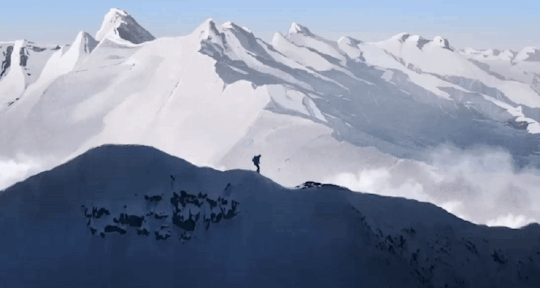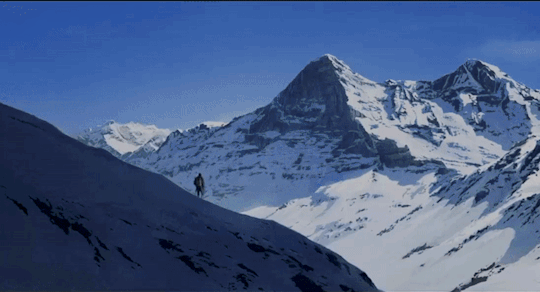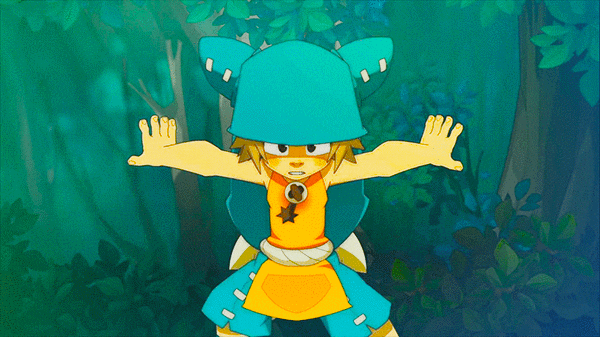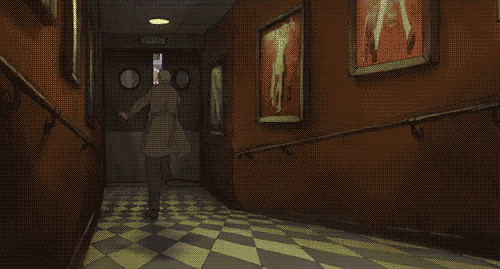originally posted at https://canmom.tumblr.com/post/698005...
This is one of those two-part Animation Night posts where we have the introduction I wrote before we watched the films, and the commentary I wrote after.
Hey everyone! Sorry we never managed to get a chance to watch the remainder of Alexander Senki. That’s still planned, hopefully sometime this weekend! Peter Chung’s later works were fascinating and varied and I look forward to writing about them at some point.
For now, though, we’re going to take a different direction! It’s been a long time since Animation Night last visited France, and in that time the French are still very busy creating some wonderful animations. So let’s cast our beady little eyes across the Channel (or Atlantic Ocean, or uh entirety of Asia, I think that covers most of the places ppl are watching from) and see what’s up!

The place of animation in various cultures is… an interesting thing imo. Whether animation is seen as for children or everyone, what sort of animated film story is prized, what sort of techniques are used - it all varies enormously across the world.
France is of course home to the renowned Gobelins animation school, and has since the late 90s pursued a trend towards making more ‘serious’, art- or drama-oriented animated films - something they’re not really alone in, in Europe. Why? I can only speculate (and such things are kind arbitrary). It might be attributed to the influence of Kirikou, or the effect of cross-pollination at the Annecy film festival, or the role of government arts funding.
In any case, the last decade or two, French animators have been really popping off. There is of course Fortiche Productions of Arcane renown, there’s Studio La Cachette, a group of Gobelins grads who went on to make Primal and Love Death and Robots, there’s Balak of Lastman and then Bobbypills productions like the delightful Peepoodo and the Super Fuck Friends. There are the autobio comics writers turned animators, like Joann Sfar (AN 114) and Marjane Satrapi (whose Persepolis we watched on AN 11, but I still owe a better writeup). And rolling back a bit we find the precise traditional animation of Sylvain Chomet (also AN 11). Along the way there’s odd little one offs springing up here and there, like J’ai Perdu mon Corps (AN 32).
So what’s new?
Let’s start with the mountain climbing movie! The Summit of the Gods (Le Sommet des Dieux) adapts a manga series by that, while not especially well known in Japan, found a big audience internationally and even helped to popularise manga in France.
So what’s it about? In 1924, George Mallory and Andrew Irvine tried to climb Everest, and vanished. This story follows a much later attempt to climb Everest: the young reporter Makoto Fukamachi who follows an enigmatic mountain climber Habu Joji who, he believes, found Mallory’s camera. Thus the film is about the character of Habu, and the reason for climbing mountains in the first place.

Everest is nowadays a place you go to exploit the Sherpas and quite possibly die, leaving a colorful corpse to act as a landmark. But it’s also figured in the world’s imagination pretty much as long as someone worked out how bloody tall the thing is. There is something fascinating in watching someone pursuing a spectacular yet self-destructive goal - c.f. the nature photographer in Jordan Peele’s recent film Nope…
So, in an article on recent French animation, Matteo Watzky (drink!) talks a little bit about this film…
Even in France, Imbert isn’t a very famous or well-established director yet. However, the studio behind the movie, studio Folivari, is rising to be one of the country’s most important animation production companies. Indeed, it was created by Didier Brunner, one of the most renowned animation producers of the last decade: he was behind the French movies Kirikou, The Triplets of Belleville, and Ernest and Célestine, but also the more European production Brendan and the Secret of Kells. In 2014, just as he was going to retire, he was convinced by his two children Damien and Pauline, to supervise creating a new studio, Folivari.
(…)
However, the one common element is in the realism: the movie is entirely 2D, and except for one or two scenes where rotoscoped 3D seems to have been used, it maintains a very high level of quality. This is exceptional, as realistic 2D characters acting on such character designs would be a feat anywhere, especially in the current French landscape. This is even more impressive considering that the movie is about mountaineering, i.e., something involving complex physical activity. The animators were assisted by professional alpinists who could provide advice and reference footage to ensure that everything was consistent and believable.
But the real highlight isn’t even this. In terms of animation proper, it is the effects: some of the snowfalls and avalanches are breathtaking in the way they convey textures. More generally, it is the art direction. The movie as a whole is built around it, with impressive sceneries and carefully-planned shot compositions. While today, many animated movies are design or art direction-driven (see, for example, Wolfwalkers or, to remain in France, Calamity), the way The Summit of the Gods is directed is slightly different and is perhaps the best proof and example of anime’s influence over Patrick Imbert and his team: the storyboarding and art direction work hand in hand, at an equal level. This entails that shot compositions and editing, properly cinematographic techniques that anime has always focused on, are polished.
It sounds great - I wish I could have seen in at the cinema, honestly. But I can bring it to you now in bitcrushed re-encoded 720p over Twitch! …why do I do this to you?

In between our two main features, I’ll be returning to a thread discussed back when we watched Mutafukaz (Animation Night 105): Studio Ankama. They’re known primarily for their Flash-based work, something which influenced Masaaki Yuasa and Eunyoung Choi during their time at the short-lived Ankama Japan to adopt the technology for use at Science Saru. And chief among those flash animated series are Wakfu and Dofus, a tie in to a pair of MMOs also titled Dofus and Wakfu, both of which take place in a 2D isometric world. And both of which seem to be still around, as far as I can tell!
The style of this is probably the thing that makes it stand out: it’s colourful and of course heavily anime-influenced in its approach to shape and line, but with the uncanny smoothness of computer inbetweening. It’s been a long time since I watched any of it, so I’m kind of curious to take another look. With 65 episodes and counting, we will definitely only be taking a sample of it.
Ankama have recently produced their first traditionally animated film, titled Princesse Dragon, but while it seems to have been released in France, I don’t seem to be able to get my hands on a copy right now.

And finally, let’s return to the court of Sylvain Chomet, with his film The Illusionist (2010) about a French magician who travels to Scotland (not to be confused with the 2006 live-action film…).
Chomet is a spectacular traditional animator. Currently 58 years old, he graduated art school in 1982, and went to London where he worked for some years in animation, primarily for adverts. In 1991 he began work on his short film The Old Lady and the Pigeons, a project which ended up taking a full five years, but made such an enormous splash that Chomet got to direct some feature-length films. The first of these, The Triplets of Belleville, (Animation Night 11) introduced the world to Chomet’s particular style of caricature and understated humour, along with technical animation to rival Disney.
In all of Chomet’s films there’s a certain sense of nostalgia, for the old media world he grew up in, and anxieties over the new capitalistic world suffocating it. Such anxieties are more explicit than ever in The Illusionist, which centres on essentially an animated version of the mime and film director Jacques Tati; it’s based on a script that Tati wrote, but never got to create.

The story focuses on an illusionist who, facing a world which is no longer interested in stage magic in comparison to other forms of entertainment, travels first to London, then finally to Scotland - impressing a girl named Alice who becomes convinced that he has real magic after all.
Chomet’s original plan was to animate the film in Edinburgh, at his newly formed studio Django Films, but soon complained about the shortage of well-trained British animators… and then found himself sacked from directing the film The Tale of Despereaux, an early-CG oddity about a food-loving rat in a medieval setting. When the film came out two years later, Chomet raised a stink, saying that Universal used his designs without credit. In the end, though, Despereaux tanked, and meanwhile Chomet’s studio - unable to find funding for what would have been a ‘Scottish Simpsons’ for the BBC - were left to focus all their efforts on The Illusionist, helped by animators in London, Dundee, Paris and South Korea.
But that’s only the beginning of the weird controversies around the film! A lot revolves around who inspired the character Alice. Tati had two daughters; there was Helga Marie-Jeanne Schiel, abandoned at birth, and the younger Sophie Tatischeff, who gave Chomet the rights to the script. In Chomet’s eyes, the film is about Tatischeff, and Schiel is not mentioned in the credits; however, in her account, the script was an attempt to reconcile with her and Chomet’s version papers over her abandonment again. This seems to have ballooned into an argument over whether the film does a disservice to Tati (even constituting a “sentimental watering-down of his art” as one colleague of Tati wrote).
Unfortunately, I don’t know the first thing about Jacques Tati, so beyond pointing to the controversy I can’t say much more than that. In any case, it promises to be beautiful, particularly in its meticulous depiction of Edinburgh.
Beyond that, I also have another little short film from Gobelins. Although it was made in 2001, this one only seems to have been released eight days ago, and it’s extremely stylish and charming, calling to mind 60s animation but decisively its own thing. We also have their crop of Annecy idents, and I believe I haven’t shown all of their 2021 films either!
So that leaves us with The Ilusionist, Wakfu and Summit of the Gods - all very different slices of what’s going on in French animation! Please come to twitch.tv/canmom and we’ll start the programme in about 20 minutes~
Anc now, my comments after...
The Illusionist
The Illusionist was, honestly, not all that great, despite the undeniable sophistication of the animation. (One thing that became apparent in the credits was that the film had been produced according to the old Disney principle where each character would be assigned a particular lead animator who would essentially be their ‘actor’ to bestow them with life and mannerisms.) The most striking positive is that the film is almost entirely wordless, with the vast majority of the story conveyed through cinematography and body language - something of a consistent thread with Chomet, although the fact it’s based on a script by a famous mime may also have something to do with it.
And there are definitely some good, darkly comic scenes; the best part is the sequence with the clown attempting suicide only to be interrupted by the girl bringing him a pie, while the magician tries to figure out if his performing rabbit is in the pie. At those points, you really saw the same chaotic sense of fun of Chomet’s previous films in a story that otherwise tried to be very grounded.
Overall, however, it lost me. Its premise requires a fairly hefty amount of buy-in; it’s asking us to sympathise with an older man essentially adopting a random girl and taking her to the city, only to find he’s unable to hold down a job so he can dote on her and she leaves him to be with a man her own age. And just like… I find it hard to feel a lot of sympathy because being a wealthy man who can bestow expensive gifts is just not a fantasy I share at all.
At the same time, we are invited to feel sad and nostalgic about the decline of the circus arts - in favour of those effeminate, flamboyant rock and roll performers! not good humble proleterian chaps like our hero - whose performers, all people who live for their art, it seems, are now homeless, or selling their souls to advertising.
And like… I’m not completely immune to this sense of nostalgia, as a traditional animation fan who likes the spirit of a lot of older works. Hell, as the current ‘AI art’ debacle is showing, the world is changing at an accelerating pace and it is hard to comprehend what place we can make for the things we are passionate about.
But… the whole affair in this film seems weird, because rock and roll is already an ‘old school’ art form that has been superseded many times over, and the film’s hyper-romantic image of circus performers (who all live in the same hotel for some reason) seems completely removed from any sort of reality of actual entertainers; they are by design essentially zero-dimensional characters entirely summed up by their performance, which is appropriate since this is a parable I guess, but it’s not a parable whose sentiment I especially agree with?
(Not to mention, if anything, stage magic would become bigger than ever with the rise of the celebrity TV magician. But that is, to be fair, a long time after Jacques Tati.)
Anyway, this leads me to thinking of the various Gobelins films that deal with circus performers…
The ethos of these films is very different to what Chomet is doing; they’re more trying to capture a relationship and moment of tension in a very unromanticised way. The first film, from 2020, portrays the moments prior to going on stage and quickly establishes the various characters’ attitudes, who’s high strung, who’s chill. The second focuses on a duo (shocker) - a long time pair of aerial silk performers, one of whom is leaving - intercutting scenes of one girl’s resentment with the performance itself.
By necessity, but also as a stylistic choice, the Gobelins student films tend to be animated at a lower framerate with less ostentatiously detailed (though still fantastic) animation. Trying to put my finger on what’s similar and different in their approach to cinematography is actually a little tricky, since both will use long still shots, and moments of quiet where you just pick up on the emotion being conveyed… I guess one big difference is that Chomet’s film has a lot of small visual gags and exaggerated caricatures while the shorter student films are alllll drama.
The main difference though is that the Gobelins films tend to just observe a particular emotional context while reserving judgement, while Chomet’s film’s exaggerations feel like an argument, like, isn’t this sad? Look, the ventriloquist’s puppet isn’t selling, how tragic! Look, the juggler’s in an alley! And as much as capitalist modernity sucks, it doesn’t feel like an angle on it that really carries me very far. At points I found myself laughing, like the magician’s final note to the girl after he leaves. Like, “sure, ok, mr Chomet, that’s what we’re going with”.
Wakfu
It’s been many years since I last watched any of Wakfu; the first time I think it lost me somewhere around the sports arc. I was kind of looking forward to seeing with adult eyes what was going on there.
It was quite interesting, in an age when there’s a serious trend across basically the entire world to look to anime, to see one of the first instances of ‘animesque’. The visual style of the show, kind of aggressively shiny and colourful, is… odd, but now I can at least recognise that it’s an aesthetic devised by a flash game developer, because it looks like a very fancy flash animation. I will definitely acknowledge that Ankama do a pretty good job of breaking up the motion tweens with original drawings and creating a good variety of layouts, and their character designs have a lot of creativity with shape and off-the-wall elements. Despite this, there is a curious sense of flatness created by the hypersaturated look.
The general vibe the show seems to be aiming for is basically… older shōnen anime, I think? But it’s very aggressively paced: a lot happens without a lot of breathing room to cushion any intended emotional beats. More than that, though, the character dynamic is so… prickly. This is ultimately what put me off the show before, and while it’s easier to digest in French, I found just two episodes of the show were more than enough to push me towards the headache zone.
I think the thing that occurred to me for comparison was the Chinese film The Legend of Hei, which we watched back on Animation Night 102. Both works have that distinctive ‘animated in Flash Adobe Animate’ feeling, and have large casts with a lot of powers which aren’t entirely explained. Hei did a much better job, though, of getting me invested in its characters and concerns.
I think Wakfu’s problem is that it seems to feel like it always needs to reach for a quip or joke, and that’s just exhausting before too long…
The Summit of the Gods
Now this film was the real highlight of the evening.
Also, I never want to climb a mountain.
I expected like… relatively quiet drama about like, why do people climb mountains. And it certainly has that - it looks like a lost 90s realist anime film, with both gorgeous environments and strong, subtle character animation. But it’s also got some truly intense scenes of climbing mishaps.
As I said above, the story follows a reporter Makoto, who becomes obsessed with a particular climber, Habu, after coming to believe Habu has ended up with a camera from Mallory’s ascent of Everest. Makoto becomes increasingly obsessed with digging into the career of Habu, who we come to learn is something of a highly driven antisocial loner, who has a habit of alienating members of his climbing club. So the film essentially becomes a character study of Habu, through Makoto’s eyes, leading up to Makoto tracking down where Habu has been living in seclusion and insisting on photographing his final attempt to climb Everest.
You can really tell how much the technical climbing information has informed this film; its depictions of equipment and techniques are downright meticulous. And this care helps to ground the gruelling scenes where, for example, Habu attempts an ascent with an eager young climber, only for the boy to end up suspended with a back injury over an overhang on a fraying rope… until he decides to cut his own rope to spare Habu the decision of killing him. Habu affects a kind of lone wolf attitude, frequently harshing the vibe of his climbing crew by saying he wouldn’t hesitate to cut a rope to save himself in a situation where there was no saving the other climber… but in practice, both times he finds himself in this situation, he finds that a whole lot harder.
Ultimately, the film itself - the atmosphere and tension it portrays - is its answer to ‘why climb mountains’. It’s about climbing in an era where climbing has increasingly become all about challenge runs - going up more difficult approaches, climbing solo, without oxygen etc. Habu is very deep into this sport, having a high profile rivalry with another climber - a man whose intervention saves Habu’s life, but then dies shortly after winning their rivalry. Habu withdraws from the climbing world, just stubbornly attempting the insane climbing feat which killed his rival. But in the end, Habu plays this out himself - he goes back down the mountain to save Makoto’s life, then dies at the top of Everest - while Makoto receives the camera, and finally feels like he understands w
it’s interesting, because artistically, this film is fantastic; but actually I don’t especially think there’s anything grand or romantic about inventing increasingly arbitrary challenge runs until you add a corpse to the growing charnel house at the top of Everest, or put some unfortunate Sherpa’s life at risk for the sake of your grand dick-waving contest. Ultimately, I am strongly reminded of the character in NieR Reincarnation who challenges himself against mountains to feel alive in a similar way, but is also just a total dumbass and neglects his family for the sake of this macho ritual. (He’s called Argo, but I prefer to call him John Mountainfucker).
But, that said, it is a very entertaining archetype of guy, and there’s definitely a fun sort of chemistry between Makoto and Habu even if it’s not anywhere near like, explicitly a gay movie.
(Also! I forgot about this when writing the prev post, but Made in Abyss was in fact heavily inspired by The Summit of the Gods, and I can really see it in scenes like the amputation scene in MiA. It’s very cool to see Summit adapted so well, and I can’t wait to see what the team does next.)
Comments